

Before You Trade Your Tractor for a Draft Horse, Consider This Expert's Sage Advice. Stephen Decater learned to farm with draft horses the hard way—by himself—when he and his wife, Gloria, started Live Power Community Farm back in the 1970s.
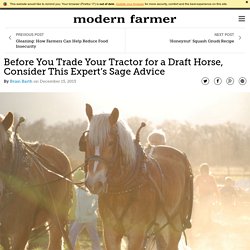
Located in Covelo, California, their 50-acre farm is certified biodynamic and powered almost entirely by a team of Belgian draft horses and an array of solar panels. Watch Tellington TTouch® Method Virtual Learning Center Online. “The day is coming when a single carrot, freshly observed, will set off a revolution.” — Paul Cezanne. Denali Draft Horses - Home of the American Cream Draft Horse. BestDraftHorse.com - Draft Horses For Sale. “The day is coming when a single carrot, freshly observed, will set off a revolution.” — Paul Cezanne. Unbalancing a Balanced Horse Feed Diet. I was helping a colleague do a horse nutrition training seminar the other day and the question came up “Is it okay to supplement a commercial feed?”
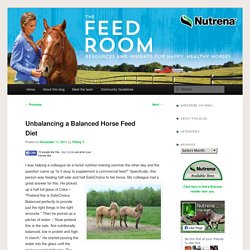
Specifically, this person was feeding half oats and half SafeChoice to her horse. My colleague had a great answer for this. H e picked up a half full glass of Coke – “Pretend this is SafeChoice. Balanced perfectly to provide just the right things in the right amounts.” 7 Most Common Horse Feeding Mistakes. We do our best to feed our horses well--and we generally succeed.
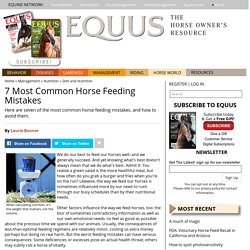
And yet knowing what's best doesn't always mean that we do what's best. Admit it: You realize a green salad is the more healthful meal, but how often do you grab a burger and fries when you're on the run? Likewise, the way we feed our horses is sometimes influenced more by our need to rush through our busy schedules than by their nutritional needs. Other factors influence the way we feed horses, too: the blur of sometimes contradictory information as well as our own emotional needs--to feel as good as possible about the precious time we spend with our animals. Usually, the consequences of less-than-optimal feeding regimens are relatively minor, costing us extra money perhaps but doing no real harm.
Horse Health and Nutrition For Dummies - Audrey Pavia, Kate Gentry-Running. Farm animal livestock feed solutions. Fodder Solutions make a climate controlled growing chamber to meet every farming need from the hobbyist to large-scale livestock producers.

They can be used strategically to keep stock alive during drought and adverse weather conditions or to provide a full diet for high production. The system is a hydroponic growing room that has been specifically developed to sprout grain and legume seeds, for highly nutritious, yet cost effective livestock feed. A selection of grains and legume seeds are spread onto the specialized growing trays and are watered at pre-determined intervals with overhead sprays. A set temperature is maintained inside the growing chamber, to ensure the best growth and highest nutritional value fodder possible. Each day you simply slide the feed out of the trays, rinse the tray, reseed and push the newly seeded tray into the other end of the system. The sprouts grow on the Fodder Solutions specially designed sprouting trays with no growing medium.
Equine Benefits - Fodder Systems - Healthy, fresh feed every day. FodderPro Feed Systems allow anyone to produce their own top-quality horse feed for just pennies a pound.
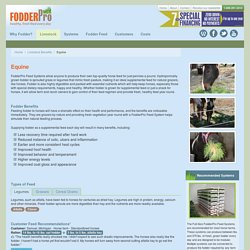
Hydroponically grown fodder is sprouted grass or legumes that mimic fresh pasture, making it an ideal supplemental feed for natural grazers, like horses. Fodder is also highly digestible and packed with essential nutrients which will help keep horses, especially those with special dietary requirements, happy and healthy. Whether fodder is grown for supplemental feed or just a snack for horses, it will allow farm and ranch owners to gain control of their feed regimen and provide fresh, healthy feed year round. Feeding fodder to horses will have a dramatic effect on their health and performance, and the benefits are noticeable immediately. Now You Can Grow Your Own (Horse Feed, of Course!)
Here's one alternative to hay.
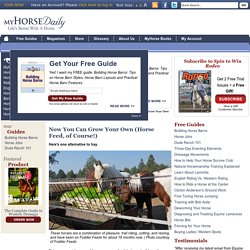
These horses are a combination of pleasure, trail riding, cutting, and reining, and have been on Fodder Feeds for about 18 months now. | Photo courtesy of Fodder Feeds Did you ever wish you could grow your own feed, but you don’t have the land? Well, maybe you should consider a hydroponic system of growing horse feed. The folks at Fodder Feeds produce a growing unit that is environmentally controlled and has automatic watering heating, cooling, lighting and humidity control. Inside the unit, you can plant 2 pounds of barley seed and it sprouts to 20 lbs of feed in 6 days. Producing Livestock Feed.
Most people have two really good reasons for making their own livestock feed: it’s much less expensive than purchasing commercial feeds, and you can control the quality and ingredients.
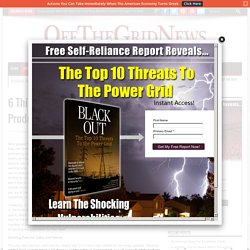
As fantastic as those two reasons are, there is one final reason that anyone wanting to be self-sufficient should do as much as they can to produce their own food for the animals they raise: as long as you are buying feed from outside sources, you aren’t able to be truly self-sufficient. You are relying on outside sources that may not always be available, and you are at the mercy of the prices they charge for sustaining your lifestyle. Thankfully, it is not really that hard to mix your own feeds. Of course, the larger the animal you are feeding is, the more difficult it will be to grow enough to support its needs. DIY Sprouted Fodder for Livestock - The Happy Homesteader. Sprouting and growing grain for livestock fodder is a simple and efficient way to not only feed your animals a more natural and fresh diet, but is also a practically effortless way to save money.
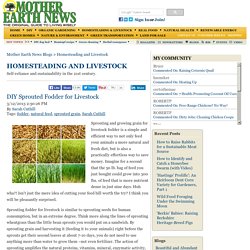
Imagine for a second that the 50 lb. bag of feed you just bought could grow into 300 lbs. of feed that is more nutrient dense in just nine days. Huh wha?! Isn’t just the mere idea of cutting your feed bill worth the try? I think you will be pleasantly surprised. Przewalski’s are the last truly wild horses on Earth.
Przewalski’s horses are wild, ancestral cousins of domesticated horses, yet the family tree dates farther back than you might expect.
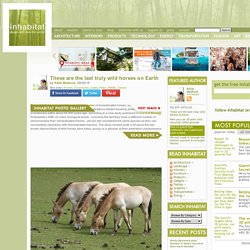
These classifications started traveling down different evolutionary paths about 45,000 years ago, according to a new study published in Current Biology. Przewalski’s differ on many biological levels - including the fact they have a different number of chromosomes than domesticated breeds - yet are still considered the same species as they can successfully reproduce with domesticated equines.
The study reveals quite a bit about the last known descendants of wild horses alive today, giving us a glimpse at their prehistoric predecessors. Experts have disagreed about whether to classify Przewalski’s as a different species for years. The team leading the current study examined the genomes of 11 wild horses, including living subjects and museum specimens more than a century old. Rural Heritage Horse Geometry.
Photo #4: Can you see the broken line of draft?

Photo #4 shows the most common manifestation of draft inefficiency. The trace carrier (or lazy strap in a Western type harness) isn’t adjusted long enough, and it is deflecting the trace from being a straight line from hame to load. This horse, of course, isn’t in draft, so the trace will be less deflected when the load is engaged. Nevertheless, the trace will still be deflected upward by the trace carrier, and there will still be an inefficient transfer of power.
In addition, with the horse feeling downward pressure on its hips from the trace pulling down on the trace carrier, there may be a balking issue or safety issue if the horse becomes concerned with that feeling of downward pressure, especially in the case of heavier loads. HeartsEase Icelandic Sheep.
Horse care, horse boarding, horse training, natural fly control - Ohio. ZERO BUG ZONE is a uniquely formulated product designed to give off a static frequency that drives insects crazy. After just a few days of use, ZBZ will drive insects out of a structure or affected area. ZBZ Zero Bug Zone - Reviews @ Horse Tack Review. It's Not I Who Seek the Horse, the Horse Seeks Me: My Path to an Understanding of Equine Body Language by Klaus Ferdinand Hempfling.
Connected Equine- and Life Consulting in personal relations, business and society. Guard Donkeys Protect the Herd - Animals. Protecting livestock is easy when you have guard donkeys in place. Buena Vista, North Carolina — Have you ever seen a cow smile? If you do see a herd of cattle with big goofy grins, it's probably not because of the growing number of vegetarians. The cows might be happy because of a chief security officer whose obnoxious braying can raise the roof off a barn — guard donkeys are at work. Oxen: A Teamster’s Guide to Raising, Training, Driving & Showing by Drew Conroy. Guard Llama Guidelines, International Llama Association. The Livestock Conservancy. Holistic Aromatherapy for Animals: A Comprehensive Guide to the Use of Essential Oils & Hydrosols with Animals by Kristen Leigh Bell. Topic: logging with goats. I’m going to suggest a walk in the woods to my girls:) *note to self* Do not show this to the goats again… now they won’t come out of the barn.
MischkaPress WI: Draft Horse, Driving Horse, Mule and Donkey Bookstore. Cream Acres Ranch and the American Cream Draft Horse ...american cream draft, draft horse, harness, pshigoda,american cream draft horse association,artificial insemination,breeding,breed,breeder,photo,heavy horse, Cream Draft available Moyie Valley Ranch : . Cream Draft Moyie Valley Ranch : . Cream Draft hotse breeder. 6 Ways to Predator-Proof Your Farm. Animals that prey on livestock and poultry are more creative and intelligent than farmers would like them to be. The species that want to prey on your livestock probably lived on your farmland before you moved in, so telling them they can't be there isn't exactly easy. You have a number of options for livestock and poultry predator control, exclusion and removal on your small-scale farm. The most effective means of preventing predation is to keep the predator from getting to your animals in the first place.
Once the predator knows there's a meal to be had, it can easily establish a pattern of attack, and that's difficult to break. Assuming you’re reading this because you have a predator problem, your first task is to determine what predators are causing problems on your farm. Predator Control for Sustainable and Organic Livestock Production. Home > Master Publication List > Predator Control for Sustainable and Organic Livestock Production This publication examines how to identify livestock predators and how to control them. Many species of animals can be classified as predators, but coyotes and dogs account for more than three-quarters of all livestock lost to predators.
Fascinating Photos of Reindeer People Living in Mongolia. Why Do Horses Sleep Standing Up?: 101 of the Most Perplexing Questions Answered about Equine Enigmas, Medical Mysteries, and Befuddling Behaviors by Audrey Pavia. Small Farmer's Journal. This article was originally published in the Summer 2012 (Vol. 36, No. 3) issue of Small Farmer’s Journal. All photos are from Natural Roots Farm except for the last, which is from Cedar Mountain Farm. Draft horse, mule, oxen power, back to the land and sustainable living - Rural Heritage online. American Cream Draft Horse Assoc. - Links.
Am. Cream Draft Horse. SVF Rare Breed Conservation Foundation, Heritage Breeds, Endangered Livestock and Rare Breed Conservation. About SVF Foundation SVF Foundation preserves germplasm (semen and embryos) from rare and endangered breeds of food and fiber livestock. Guard LlamasSVF Foundation, Heritage Breeds, Endangered Livestock and Rare Breed Conservation. A Modern Horse Herbal by Hilary Page Self. Caspian Horse. The Caspian is an ancient breed previously believed to have been extinct for over one thousand years. This breed is probably the most direct ancestor of the Oriental breeds and subsequently of all light horse breeds.
Fell Pony - The Livestock Conservancy. Gotland (Swedish) - The Livestock Conservancy. The Gotland is native to the island of Gotland in Sweden, where ponies of this type have been documented as far back as the Stone Age. Kokovoko Gotland Ponies. Gotland Horse. Rocky Mountain - The Livestock Conservancy. Irish Draught. The Livestock Conservancy. The Irish Draught breed was first mentioned on record in the late 1700’s. Exmoor Pony - Livestock Conservancy. Horse Breeds. Exmoor Pony. Dartmoor - Livestock Conservancy. Dales Pony - The Livestock Conservancy. Canadian - Livestock Conservancy. Akhal-Teke - The Livestock Conservancy. Suffolk - The Livestock Conservancy. Newfoundland Pony. The Livestock Conservancy. Hackney The Livestock Conservancy. Cleveland Bay -The Livestock Conservancy. Caspian, The Livestock Conservancy. Cream Draft horse, The Livestock Conservancy. A Conservation Breeding Handbook by D. Phillip Sponenberg.
Breeds of Livestock - Clun Forest Sheep. Home. Mother Earth News guard animals. Wisconsin Life - Horse Powered Logging Taylor Johnson’s family has... Infographic: Pick Your Predator Patrol. Welcome to Gemini Mini Llamas - Gemini Farms. Livestock Guardian Animals: Donkeys, Llamas, and Livestock Guardian Dogs to Protect Your Property and Stock by Jim Mitchell. Livestock Guardians: Using Dogs, Donkeys, and Llamas to Protect Your Herd by Jan Vorwald Dohner. Straight from the Horse'a Mouth by Amelia Kinkade.
The Green Guide for Horse Owners and Riders: Sustainable Practices for Horse Care, Stable Management, Land Use, and Riding by Heather Cook. The Tao of Equus: A Woman's Journey of Healing and Transformation Through the Way of the Horse by Linda Kohanov. Riding Between the Worlds: Expanding Our Potential Through the Way of the Horse by Linda Kohanov. Tellington TTouch Training™ Fermentation on Wheels: Bringing Culture(s) to the People. The New Horse-Powered Farm: Tools and Systems for the Small-Scale Sustainable Market Grower by STEPHEN LESLIE. Horse drawn Bakery Wagon. This Motown Singer Turned His Wild Mustang Ranch Into a Summer Camp for Baltimore Kids by Valerie Williams.